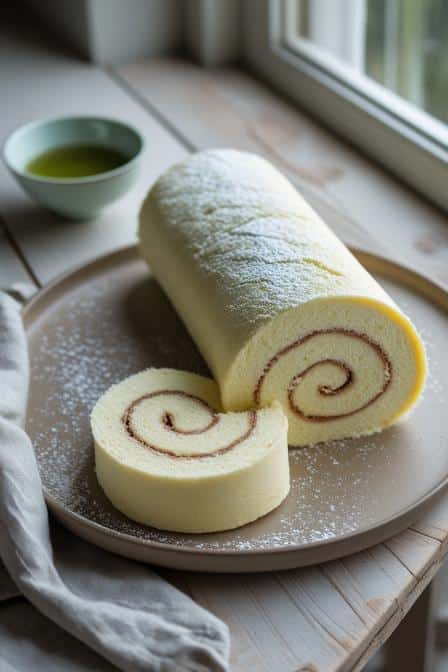There I was, 3am in Tokyo, sleepless and sugar-starved, standing in front of a 24-hour patisserie window watching a Swiss roll so soft it trembled when the chef exhaled near it. That roll didn’t just look fluffy. It looked like it could evaporate if you whispered too loud. That was the moment I knew the Japanese cotton candy Swiss cake roll was something altogether different. This ain’t your grandma’s jelly-roll, friend. It’s a dessert engineered with the precision of a watch and the whimsy of a cloud.
What Is a Japanese Cotton Candy Swiss Cake Roll?
You take the elegance of French baking, the fun of a carnival cotton candy cone, and then infuse it with the restraint and finesse only the Japanese could pull off. A Japanese cotton candy Swiss roll is a pillowy chiffon sponge cake, rolled up with whipped cream or flavored mousse, with a structure so light it nearly levitates.
The magic lies in the meringue and the steam-baked sponge. Not quite a souffle. Not quite a castella. It’s like something dreamt up by a pastry chef who accidentally fell asleep on a cloud. This cake doesn’t just melt in your mouth. It disappears, leaving behind only sighs and possibly existential thoughts.
It’s special because of technique. Not just ingredients. You must get the eggs right. The folding right. The rolling right. And oh, don’t you dare overbake it—that’d be murder.
Ingredients & Substitutions
Here’s what you’ll need and how to tweak it if needed:
| Ingredient | Quantity | Purpose & Notes | Substitutes |
|---|---|---|---|
| Cake flour | 60g | Low-protein flour = tender sponge | Pastry flour or sifted all-purpose (minus 1 tbsp) |
| Granulated sugar | 70g | Divided use: sweetness and meringue stabilization | Caster sugar works better if available |
| Large eggs (room temp) | 4 | Separated; yolks for richness, whites for structure | No real sub for egg whites if making meringue |
| Whole milk | 40ml | Moisture and tenderness | Oat or almond milk (unsweetened) |
| Neutral oil (canola, grapeseed) | 30ml | Keeps the sponge moist and supple | Melted unsalted butter (but cake may be firmer) |
| Cream of tartar | 1/4 tsp | Helps stabilize egg whites | 1/2 tsp lemon juice or vinegar |
| Vanilla extract | 1 tsp | Flavor and aroma | Almond or matcha extract for variation |
| Heavy whipping cream | 200ml | For filling | Coconut cream (chilled and whipped) |
| Powdered sugar | 15g | Sweetens the cream | Skip or adjust to taste |
Egg freshness matters here. Older whites won’t hold as stable a meringue. And for heaven’s sake, use a metal or glass bowl when beating them. Any grease, even ghost-level traces, will kill your lift.
Step-by-Step Instructions
1. Preheat & Prep
Oven at 170°C (340°F). No fan.
Line a 10×10″ Swiss roll pan with parchment. Not wax paper, not foil. Parchment. If you skip this step, your cake will attach to the pan like it has abandonment issues.
2. Make the Yolk Batter
In a bowl, whisk together the yolks, half the sugar (35g), oil, milk, and vanilla until pale and slightly thick. Sift in cake flour. Gently fold until just combined. No overmixing. It should look like custard, not paste.
3. Whip the Meringue
In a separate bowl, start whipping egg whites on low. When frothy, add cream of tartar. Gradually add remaining 35g sugar. Beat to glossy medium-stiff peaks. Not dry. Not foamy. Peaks that lean like they’re flirting.
4. Combine
Take 1/3 of the meringue, stir it into yolk batter to lighten it up. Then fold the rest in gently, in 2 more additions. Use a J-fold motion. Think of it like hugging a kitten—firm but gentle.
5. Bake
Pour batter into pan. Smooth it out with an offset spatula. Give the tray a few firm taps on the counter. Pop any big bubbles.
Bake for 18 minutes. Not 17. Not 19. The top should be pale golden, springy to touch, and pulling from the edges slightly. Don’t open the oven like an eager raccoon. Let it be.
6. Cool & Roll
Once out, immediately flip onto a parchment-lined cooling rack. Peel parchment from base. While still warm, roll cake up gently with a clean sheet of parchment inside. This pre-roll trains the cake to stay curled. Let it cool completely.
7. Make the Filling
Whip cream with powdered sugar to soft peaks. Add a smidge of vanilla if you like. Or matcha. Or freeze-dried strawberry powder. Don’t go too stiff—this isn’t wall plaster.
8. Fill & Final Roll
Unroll cake. Remove inner parchment. Spread whipped cream evenly, leaving 1 inch border at the end. Re-roll gently but firmly. Wrap in cling film. Chill 1-2 hours before slicing.
If you cut it too early, it’ll squish. If you overfill, it’ll weep. Respect the roll.
Cooking Techniques & Science
The real science star here? Meringue.
Egg whites, when whipped, trap air in a network of proteins. Add sugar gradually, and you stabilize the whole structure. Bake it right, and that structure sets into something impossibly soft yet sliceable.
Oil replaces butter because butter hardens when chilled. Oil keeps the cake pliable even cold. That’s why your Swiss roll won’t crack when you slice it cold from the fridge. It’s chemistry and choice.
Steam baking is also key. Japanese ovens often use a water tray to create humidity. Lacking that? Toss a small oven-safe dish of hot water in with your tray.
Tools You Need
- Offset spatula
- Electric hand mixer or stand mixer
- Silicone baking mat or parchment
- Kitchen scale (volume is risky here)
- Sharp serrated knife
How to Store & Reheat
Wrap the roll in cling film. Store in fridge up to 3 days. You can freeze it, but the texture suffers.
To thaw: move to fridge 6 hours before serving. Never microwave. Ever.
Variations & Substitutions
Matcha Swiss Roll: Add 1 tsp sifted matcha to flour.
Strawberry Cotton Roll: Fold chopped fresh strawberries into whipped cream.
Vegan Version: Sub aquafaba for egg whites (though results are trickier), and use coconut cream + almond milk.
Gluten-Free: Use rice flour or a 1:1 gluten-free blend. But note, the texture will be slightly more chewy.
Serving & Pairing Suggestions
Slice with dental floss or a hot knife. Wipe between each cut.
Serve it with matcha tea, iced hojicha, or even a dry prosecco. For presentation, dust with powdered sugar, edible flower petals, or go full kitsch with a swirl of cotton candy perched on top.
You can even drizzle with white chocolate ganache. Just don’t overpower it. The whole point is the cake’s whisper-light touch.
Best Time to Serve
Right after dinner. Or mid-afternoon with tea. Or breakfast. No judgment.
Honestly, it’s the kind of cake that fits wherever grace and joy are needed. It turns an ordinary moment into a small, delicious celebration.
Conclusion: Final Thoughts from a Flour-Dusted Mind
This cake is not difficult. It’s delicate. And that’s a big difference.
What makes the Japanese cotton candy Swiss cake roll special isn’t complexity. It’s care. It’s about watching your egg whites like a hawk. Rolling with a steady hand. And treating that sponge like it’s a piece of silk from Kyoto.
Make it once and you’ll fail. Maybe twice. But when you finally slice a perfect spiral and hear someone go “Wow” under their breath, it’ll all feel worth it.
And hey. If it cracks? Just call it rustic. That’s what all the good chefs do.
FAQs
1. Why did my roll crack when I rolled it?
Probably overbaked, or you let it cool too long before the initial roll. Next time, roll it while it’s still warm to prevent cracking.
2. Can I use butter instead of oil?
You can, but it may firm up more in the fridge and risk cracking when sliced.
3. What if I don’t have cream of tartar?
Use a few drops of lemon juice or vinegar to stabilize the meringue.
4. Can I double the recipe for a bigger cake?
Yes, but be careful with baking time and pan size. Don’t double it into a regular 9×13—use two pans or a large jelly roll pan.
5. My whipped cream is leaking. What happened?
It was either under-whipped or your filling sat too long before use. Whip to soft peaks and fill immediately.

